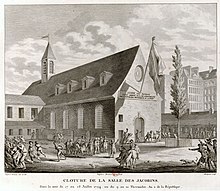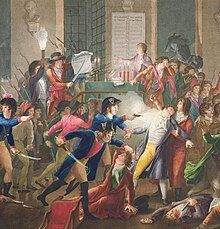Thermidorian Reaction

In the historiography of the French Revolution, the Thermidorian Reaction (French: Réaction thermidorienne or Convention thermidorienne, "Thermidorian Convention") is the common term for the period between the ousting of Maximilien Robespierre on 9 Thermidor II, or 27 July 1794, and the inauguration of the French Directory on 2 November 1795.
The "Thermidorian Reaction" was named after
Etymology and definitions
The name Thermidorian originated with 9
Background

Conspiracies against
Troops from the

On that very day, Robespierre was executed with twenty-one of his closest associates, including[6] François Hanriot, ex-commander of the Parisian National Guard; Jean-Baptiste Fleuriot-Lescot, mayor of Paris; Georges Couthon, Louis Antoine de Saint-Just and René-François Dumas, ex-president of the Revolutionary Tribunal.
The Reaction
The events of 9 Thermidor proved a watershed in the revolutionary process. The Thermidorian regime that followed proved to be an unpopular one, facing many rebellions after its execution of Robespierre and his allies, along with seventy members of the Paris Commune, the largest mass execution to have ever taken place in Paris.[7] This led to a very fragile situation in France.[8]
The hostility toward Robespierre did not just vanish with his execution. Instead, the people decided to blame those who were involved with Robespierre in any way, namely the many members of the Jacobin Club, their supporters, and individuals suspected of being past revolutionaries. The massacre of these groups became known as the White Terror, and was partially carried out by the Muscadin, a group of dandyish street fighters organized by the new government.[8]
Often, members of these targeted groups were the victims of prison massacres or put on trial without due process, which were overall similar conditions to those provided to the counter-revolutionaries during the Reign of Terror. At the same time, its economic policies paved the way for rampant inflation. Ultimately, power devolved to the hands of the Directory, an executive of five men who assumed power in France in November 1795 (in year III of the French Revolutionary calendar).[9][page needed]
The Thermidorian regime excluded the remaining Montagnards from power, even those who had joined in conspiring against Robespierre and Saint-Just. The White Terror of 1795 resulted in numerous imprisonments and several hundred executions, almost exclusively of people on the political left. These numbers, while significant, were considerably smaller than those associated with the previous Reign of Terror, which killed over 40,000. Many executions took place without a trial.[10][page needed]
On July 29 the victors of the 9th Thermidor condemned seventy members of the
As part of the reorganization of French politics, practitioners of the terror were called to defend their records; some such as
In April and May 1795, protests and riots in support of the radicals broke out culminating in an invasion of the convention by an insurrectionist mob on 20 May. On 22 May the Convention struck back, having troops under
Meanwhile, French armies overran the
Other uses of the term
For historians of revolutionary movements, the term Thermidor has come to mean the phase in some revolutions when power slips from the hands of the original revolutionary leadership and a radical regime is replaced by a more conservative regime, sometimes to the point where the political pendulum may swing back towards something resembling a pre-revolutionary state.[12]
About the Russian Revolution
In his book The Revolution Betrayed, Leon Trotsky alleges that the rise of Joseph Stalin to power was a Soviet Thermidor for not restoring capitalism, yet still being a counterrevolutionary regression within the regime of the USSR, just like the Thermidor in France did not restore the monarchy but did, in his opinion, reverse revolutionary gains.[13]
Some Marxist-Leninists argue that Nikita Khruschev's rise to power in Russia, and his economic policies were a kind of Thermidor within the Soviet Union.[14] A CIA document considers Khruschev's denunciation of Stalin may have marked the "Thermidor" of the Russian Revolution.[15]
References
- ^ After Robespierre THE THERMIDORIAN REACTION By ALBERT MATHIEZ, p. 23 Translated from the French by Catherine Alison Phillips
- Harper & Brothers. p. 379.
- ISBN 9781118316399.; Andress, David, ed. (2015). The Oxford Handbook of the French Revolution. Oxford University Press. pp. 522–523.; Mona Ozouf, François Furet (ed.), A Critical Dictionary of the French Revolution. Harvard University Press(1989). p. 400.
- ^ de Maillane, Durand; Lanjuinais, Jean-Denis (1825). Histoire de la Convention Nationale (in French). Paris: Baudouin Freres. p. 200.
- ^ ISBN 0-393-92495-5.
- ^ Beauchesne, Alcide; Dupanloup, Félix (1868). Louis XVII, sa vie, son agonie, sa mort: captivité de la famille royale au Temple. H. Plon. pp. 218–9.
- ^ a b Durant & Durant 1975, p. 83.
- ^ ISBN 9781118316399.
- ^ Sutherland 2003, ch. 8.
- ^ Brown 2010.
- ^ Durant & Durant 1975, p. 84.
- ^ "Definition of THERMIDOR". www.merriam-webster.com. Retrieved 1 May 2021.
- ^ Trotsky, Leon (2004) [1937]. "The Soviet Thermidor: Why Stalin Triumphed". The Revolution Betrayed. Translated by Eastman, Max (Dover ed.). Doubleday, Doran & Co. pp. 66–87.
A secondary figure before the masses and in the events of the revolution, Stalin revealed himself as the indubitable leader of the Thermidorian bureaucracy, as first in its midst.
- ^ Buttafava, Ubaldo (1997). Khrushchev's Thermidor - A contribution to the critical analysis concerning the USSR's return to capitalism (PDF).
- ^ Anonymous CIA agent. "Latest developments of the "anti-Stalin" trend in international Communism, interpretation and possible exploitation" (PDF). CIA.
Works cited
- Brown, Howard G. (2010). "Robespierre's Tail: The Possibilities of Justice after the Terror". Canadian Journal of History. 45 (3): 503–536. .
- Durant, Will; Durant, Ariel (1975). The Age of Napoleon. New York: Simon & Schuster.
- Sutherland, D.M.G. (2003). The French Revolution and Empire: The Quest for a Civic Order.
Further reading
- Baczko, Bronislaw (1989), Comment sortir de la Terreur (in French), Gallimard
- Barthou, Louis (1926), Le neuf Thermidor (in French), Hachette
- Brunel, Françoise (1989), Thermidor, la chute de Robespierre (in French), Ed. Complexe
- Héricault, C. d' (1876) (in French), La Révolution de Thermidor, Didier
- Lefebvre, Georges (1937). Les Thermidoriens (in French). Armand Collin.
- Madelin, Louis (2002), Fouché, de la Révolution à l'Empire (in French), vol. 1 (Reedition ed.), Nouveau Monde Editions
- Linton, Marisa (August 2006). "Robespierre and the Terror". History Today. 56 (8): 23–29. Archived from the original on 2007-03-13.
- Mathiez, Albert (1965) [1931]. After Robespierre: The Thermidorian Reaction (PDF). Translated by Phillips, Catherine Alison. Grosset & Dunlap. LCCN 65-14385. Translation of Mathiez, Albert (1929). La Reaction Thermidorienne (in French).
- Madelin, Louis (2002), Fouché, de la Révolution à l'Empire (in French), vol. 1 (Reedition ed.), Nouveau Monde Editions
- Koekkoek, René (2020). The Citizenship Experiment Contesting the Limits of Civic Equality and Participation in the Age of Revolutions (PDF). Studies in the History of Political Thought. Vol. 15. Leiden: Brill. LCCN 2019038014.
- Neely, Sylvia (2008), A Concise History of the French Revolution
- ISBN 978-0-691-05119-2. A study of the Committee of Public Safety.
- Saurel, Louis (1962), Le Jour où finit la Terreur(in French) , Robert Laffont
- ISBN 978-0-394-55948-3. A revisionist account.
